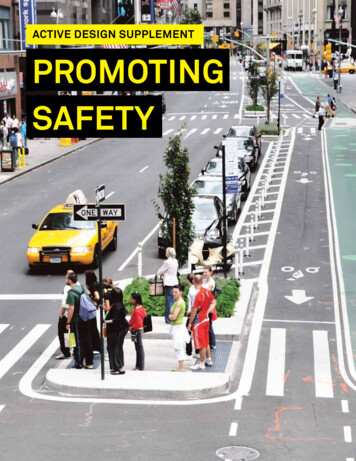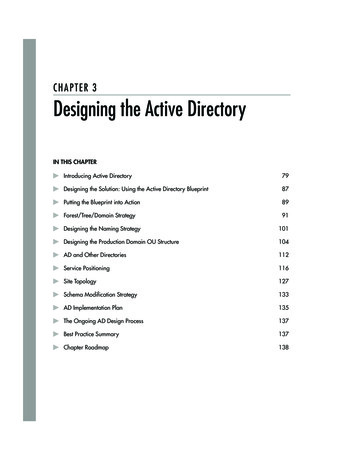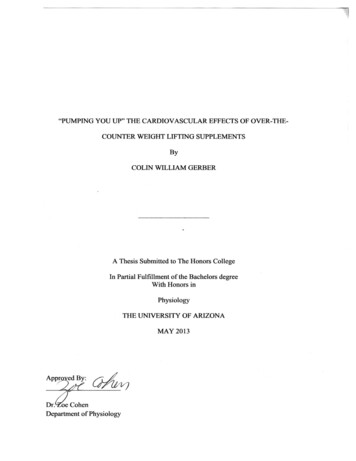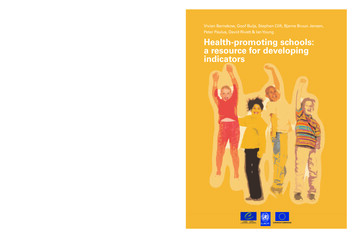
Transcription
Active design supplementpromotingsafety
Hester Street Playground,Chinatown, Manhattan
ACTIVE DESIGNs u p p le m e ntPROMOTING saf ety
A M ER ICA NI NSTITUTE OFA RCH ITECTSN EW YOR KI NTRODUCTIONThe City of New York should be commended, anew, for developing a cogent andconcise supplement to the Active Design Guidelines with a particular focus on safetyin our built environment. This document draws upon specific examples to illustratethe most effective design strategies for achieving a more physically active – andsafe – way of living in New York City.The tenets of the Active Design Supplement: Promoting Safety draw upon evidence,case studies, and principles visible in New York City where injury preventionstrategies increasingly align with Active Design. Through the conscientiousintegration of these strategies into projects of all scales, design professionals canrealize buildings and neighborhoods that seamlessly integrate more healthful andactive living with attention to design excellence, sustainability and safety.The New York Chapter of the American Institute of Architects is dedicatedto design excellence, professional development, and public outreach. The City’sActive Design Supplement: Promoting Safety, produced as a partnership with the JohnsHopkins Center for Injury Research and Policy and the Society for Public HealthEducation, combines these goals in a well-written addendum that should be usedby all architects, designers, and building owners in concert with the Active DesignGuidelines as both reference and resource.Joseph Aliotta, AIA2012 P r esi den tAIA New YorkFredric Bell, FAIAE x ecu t i v e Di r ectorAIA New York
TA BLE OFCONTENTSPreface004Executive Summary006Chapter 1Introduction010Chapter 2Urban Design Strategies that Promote Safety020Chapter 3Building Design Strategies that Promote Safety046Chapter 4Conclusion062The design strategies identified in this document are for informationalpurposes only. These strategies are not specific to any particular municipality,and all designs remain subject to case by case review based on establishedengineering standards and professional judgment, with safety being ofparamount importance. The guidance presented in this document does notsupersede any existing federal, state or local laws, rules, and regulations.Please note that any previous versions of this Supplement are superseded bythis version currently found online.PROMOTING SAFETY3
PREFACEThe Institute of Medicine (IOM) report, The Future of the Public’s Health in the 21stCentury, outlined a new vision for public health, based in part on the evidence thatthe health of populations and individuals is shaped by a wide range of factors in thesocial, economic, natural, built, and political environments. To improve the public’shealth, the IOM called for, “building a new generation of intersectoral partnershipsthat draw on the perspectives and resources of diverse communities and activelyengage them in health action.” 1The Active Design Guidelines Promoting Physical Activity and Health in Design,2has received wide acclaim as an intersectoral partnership effort among the NewYork City Departments of Health and Mental Hygiene, Design and Construction,Transportation, and City Planning, along with other city agencies, academicpartners, private sector partners, and the American Institute of Architects NewYork Chapter. The Guidelines address ways that the architectural, buildings,landscape, urban design and planning, and transportation sectors can seamlesslyencourage more healthful and active living through design, construction andoperational improvements to buildings, streets, and neighborhoods, as well as theiramenities. The implementation of Active Design in the building and urban realmshould also contribute to prevention of injury.This document, Active Design Supplement: Promoting Safety, aims to providethose working in urban design and building design with additional information onhow to build in safety to mitigate injuries while also promoting active environments.It serves as a companion to the original Active Design Guidelines, and to ourknowledge, is the first document that identifies injury prevention strategies thatalign with Active Design. In total, 18 complementary strategies were identified forUrban Design and 9 strategies for Building Design by drawing on existing studiesand well-accepted best practices for maximizing safety. These strategies can beapplied to create health-enhancing built environments that also help to reduce therisk of intentional and unintentional injuries.The multidisciplinary collaboration of the publication’s authors - representingmultiple sectors of local government, an academic injury research center, and a nonprofit professional organization - is yet another example of how collective expertise andefforts are essential to promote both active living and safety. We are grateful to the U.S.Centers for Disease Control and Prevention’s Division of Unintentional Injury Preventionand Control for supporting the development and dissemination of this publication.The active alliance across the fields of architecture, urban planning, buildingdesign, injury prevention, behavioral science, and health education represents excitingpossibilities for future improvements in the health of our nation. We look forward toadditional joint efforts in action, including surveillance, research, and collaboration tohelp realize the public health goals of the 21st century.4acti v e d esign s u pp l ement
pr i m a ry au t hor s:con t r i bu t i ng e di t or s:Johns Hopkins Center for InjuryResearch and Policy, Johns HopkinsBloomberg School of Public HealthNew York City Department of Healthand Mental HygieneKeshia M. Pollack, PhD, MPHAssociate ProfessorMaryanne M. Bailey, MPH, CPHResearch Program ManagerKaren K. Lee, MD, MHSc, FRCPCDirector, Built Environmentand Healthy HousingSarah Wolf, MPH, RDCommunity Engagement Coordinator,Built Environment and Healthy HousingSociety for Public Health EducationAndrea C. Gielen, ScD, ScMProfessor and DirectorM. Elaine Auld, MPH, MCHESChief Executive Officer1.2.Institute of Medicine. (2002). Who Will Keepthe Public Healthy? National Academy ofSciences, Washington, DC.New York City Department of Health. (2010).Active Design Guidelines: Promoting PhysicalActivity and Health in Design.See also www.nyc.gov/adg.s u g g e s t e d c i tat i o nJohns Hopkins Center for Injury Researchand Policy, NYC Department of Health andMental Hygiene, Society for Public HealthEducation. Active Design Supplement:Promoting Safety, Version 2, 2013.PROMOTING SAFETY5
EX ECUTIVESUMM A RYCreating health-enhancing built environments can both promote health andreduce injuries. Drawing on the latest academic research and best practices inthe field of injury prevention, this report aims to provide professionals in urbandesign and building design with additional information on how to build in safetywhile promoting active environments. In the U.S., diseases related to obesity andphysical inactivity are among the top leading causes of death. Efforts to addressthese problems must consider the fact that injuries are the leading cause of deathfor Americans ages 1 to 44, with transportation-related injuries the most commoncause. Urban design strategies that address neighborhoods, streets, and outdoorspaces can be implemented to reduce injuries while simultaneously encouragingwalking and bicycling and increasing access to public transit. Building designstrategies that affect where individuals live, work, and play can be implemented topromote both an active lifestyle and safety.This supplement to the Active Design Guidelines was created to provideadditional information for designers, architects, planners, and engineers onimplementing Active Design strategies that promote active living and maximizesafety. The supplement provides injury prevention strategies for both urbandesign and building design. Each strategy is linked to the corresponding objectivesof the original Guidelines. Where appropriate, recommended injury preventionstrategies that are consistent with strategies from the New York City InclusiveDesign Guidelines are cited accordingly. The injury prevention strategies were ratedaccording to the strength of the supporting research evidence:Strong EvidenceEmerging EvidenceBest Practice18 Urban Design Strategies that May Reduce Injury Risk1. Playground Equipment and Surfaces2. Fencing for Swimming Pools and Elevated Play Areas3. Complete Streets4. Street Closures for Creating Safe Play Areas5. Traffic Calming6. Pedestrian Islands7. Placement of Bus Stops and Bus Lanes8. In-Pavement Flashing Lights9. Multi-Way (All Way) Stop Sign Control6acti v e d esign s u pp l ement
10. Traffic Signals11. Lighting12. Pedestrian Overpasses13. Painted, Designated Bicycle Lanes/Boxes/Crossings14. Bicycle-Sharing Systems15. Bicycle and Bicycle Helmet Storage16. Crime Prevention through Environmental Design (CPTED)17. Signage18. Stair Features9 Building Design Strategies that May Reduce Injury Risk1. Stair Features2. Surfaces in Indoor Play Areas3. Indoor Pool Safety4. Bicycle and Bicycle Helmet Storage5. Window Guards and Balcony Railings6. Signage7. Sprinklers8. Crime Prevention through Environmental Design (CPTED)9. LightingSeveral key findings emerged from the evidence reviewed. First, Active Designstrategies are often wholly compatible with well-accepted injury preventionprinciples, for example, where properly built bike lanes offer good streetconnectivity and are supported with appropriate, well-displayed signage andtraffic controls. Second, the safety of multiple Active Design strategies can oftenbe enhanced simultaneously by a single injury prevention strategy, for example,where improved timing of traffic signals benefits pedestrians, bicyclists, and transitusers. It is also important to note that motor vehicle drivers and passengers willalso be better protected when Active Design strategies that reduce crash risk,such as traffic calming, are implemented. Finally, for several of the Active Designobjectives included in this report, there is not yet evidence on the ways in whichinjury outcomes are involved, and further research is needed.Three conclusions can be drawn from these findings. First, efficient useof resources demands that highest priority be given to well-studied and costeffective strategies to mitigate injury risk while promoting active environments.A comprehensive approach to Active Design initiatives should include support forresearch and evaluation. Second, there should be be opportunities for input frominterdisciplinary experts in injury prevention, as well as from the community beingserved, particularly where the research evidence for safety is lacking. Finally, ascommunities throughout the world implement creative designs to promote activeenvironments and healthy lifestyles, there should be widespread opportunities forboth professionals and the public to share experiences and lessons learned.PROMOTING SAFETY7
chapter oneINTRODUCTIONBrooklyn, NY
chapter oneINTRODUCTIONDrawing on the latest academic research and best practices in the field of injuryprevention, this report aims to provide those working in urban design and buildingdesign with additional information on how to build in safety to mitigate injury riskwhile promoting active environments. In the U.S., diseases related to obesity andphysical inactivity are among the top leading causes of death. Efforts to addressthese problems must consider the fact that injuries are the leading cause of deathfor Americans ages 1 to 44 (see Figure 1), with transportation-related injuries themost common cause. There has been growing recognition that focusing on creatinghealth-enhancing built environments can promote health and reduce injuries.1,2,3,4Urban design strategies that address neighborhoods, streets, and outdoor spacescan be implemented to reduce injuries while simultaneously encouraging walkingand bicycling and increasing access to transit. Building design strategies that affectwhere individuals live, work, and play can be implemented to promote both anactive lifestyle and safety. It is important to note that many Active Design strategiesmay reduce injury risk to all people. For example, traffic calming reduces vehiclef i g u r e 1: T e n L e a d i n g Ca u s e s o f D e at h w i t h I n j u r y H i g h l i g h t e d, U n i t e d S tat e s , 2 0 0 9 , A l l Ra c e s , B o t h S e x e s .10 Leading Causes of Death by Age Group, United States – 2009Age Groups15-2425-34Rank 11-45-910-1435-4445-5455-6465 Chronic Low.RespiratoryDisease14,160Chronic LowRespiratoryDisease117,098Chronic nalInjury1,181HeartDisease154Influenza entionalInjury118,0216Placenta Cord.Membranes1,064Influenza &Pneumonia146HeartDisease97Influenza erialSepsis652Septicemia71Chronic Low.RespiratoryDisease64HeartDisease120Influenza &Pneumonia418Influenza ease9,154Influenza Distress595Chronic Low.RespiratoryDisease66BenignNeoplasms40Chronic betesMellitus604Cerebrovascular1,916Chronic ,465Influenza erebrovascular32Cerebrovascular42Chronic Low.RespiratoryDisease187LiverDisease459Influenza &Pneumonia1,314Influenza ide36,909Data Source: National Vital Statistics System, National Center for Health Statistics, CDC.Produced by: Office of Statistics and Programming, National Center for Injury Prevention and Control, CDC using WISQARS .CS23040910acti v e d esign s u pp l ement
chapter oneintro d u ctionspeeds, which in turn reduces injury risks to motor vehicle drivers and passengers,as well as to pedestrians and cyclists. In addition, building design strategies suchas adequate lighting in stairwells protect all users.This document is a supplement to the initial New York City Active DesignGuidelines, and it follows a similar structure and approach. Injury preventionstrategies are provided for both Urban Design and Building Design, and eachstrategy is linked to the corresponding objectives of the original Guidelines.Where appropriate, recommended injury prevention strategies are consistentwith strategies from the New York City Inclusive Design Guidelines, and are citedaccordingly. The injury prevention strategies reviewed here were rated accordingto the strength of the supporting research evidence, using the following criteria:Strong Evidence: Indicates design strategies supported by a pattern ofevidence from longitudinal or cross-sectional studies, or from the strength ofexisting research that allows us to identify a strong relationship between thestrategy and a reduction in injury risk. Strategies that come from federal agencyrecommendations are also considered to have strong evidence.Emerging Evidence: Indicates design strategies supported by an emerging patternof research. Existing studies imply that the suggested strategy will likely lead toreduced injury risk, but the evidence is not yet definitive.Best Practice: Indicates design strategies without a formal evidence base.However, principles of injury prevention, theory, common understandings ofbehavior, and experience from existing practice indicate that these measures willlikely reduce injury risk.A brief summary of the evidence for the strategy is also included with each rating.The document concludes with a number of overarching recommendations andconclusions.There is evidencethat urban designstrategies such asseparate bike pathscan be implementedto reduce injurieswhile simultaneouslyencouraging bicycling.Canal Street, ManhattanPROMOTING SAFETY11
chapter oneintro d u ctionImportance of Injury PreventionNearly 180,000 people die each year as a result of unintentional injuries or actsof violence, and 1 in 10 sustain a nonfatal injury serious enough to be treated in ahospital emergency department.5,6 Lifetime costs associated with the 50 millioninjuries Americans suffer each year are estimated at 406 billion.7 Injuries occurat home, at work, at school, on the road, and during play, and the characteristics ofthese built environments can increase or decrease the risk of injury.Strategies for Injury PreventionWilliam Haddon, the father of modern injury epidemiology, introduced the conceptthat injury results from the interaction between injury-producing agents (forexample, kinetic energy transferred to a person when hit by a car), host factors(a young, inexperienced bicyclist without a helmet), and the environment (roadsurfaces, signs, weather).8 Haddon developed a framework (Haddon Matrix, seeFigure 2) that is valuable for identifying strategies (e.g., bicycle lanes) to help preventa dangerous event (e.g., a bicycle crash) from happening, to prevent an injury if theevent happens (e.g., wearing a helmet), and to minimize the severity of the injury ifit does happen (e.g., emergency medical treatment). Environmental factors such assafety infrastructure, traffic calming, safe surfacing, and neighborhood and streetdesign are often highlighted as important strategies for preventing transportationrelated injuries.An important conceptual approach to prevention strategies is to considerthe role of engineering and designing the built environment, enforcing laws andpolicies, and educating individuals—also known as “the Three E’s” of injuryprevention (see Figure 3). Although the existing scientific literature demonstratesthe importance of including behavioral interventions to reduce injury risk, 9structural and environmental interventions that involve designers, architects, andbuilders play a key role. Such interventions can ultimately protect individuals (e.g.,protected bicycle lanes), and they can make the safer behavior the easier behavior(e.g., improved pedestrian signals). Most often, multiple strategies are needed toprovide comprehensive injury prevention solutions (e.g., presence of sidewalksFigure 2: HaddonMatrix Application toWalking 8Pre-event:Prevent a crashhost( h u man )vector( v ehic l e )Educate public to usepedestrian walkways.Increase visibility ofpedestrians to alert driversso they can avoid hitting them.Include traffic calmingstrategies and separatepedestrians from traffic.Restrict maximum allowablespeed of vehicles.Enforce strong traffic safetylaws (e.g., driving laws).Designs should considerhow speed at vehiclepedestrian impact, vehiclesize, and hardness andsharpness of contactsurfaces affect injury risk.Designs should consider howroad and environmental designpolicies can reduce injury risk.Educate pedestrians aboutthe importance of awarenessof motor vehicles, even whenin walkways or when havingthe right of way.Event:Prevent an injurywhen there is a crashDesigns should consider howpedestrian characteristics(e.g., age) affect injury risk.Educate public about firstaid and bystander response,including bystander injuryavoidance.Post-event:Reduce the severityof the injury whenthere is a crash12Educate public about first aidand bystander response.Design vehicles with fuelsystem integrity to reduce therisk of a fire.environment( physica l an d socia l )Install and maintain emergencyphones along streets andpedestrians paths.Promote effective traumasystem response.acti v e d esign s u pp l ement
Stairs into the HighLine Park, Manhattan,James Corner FieldOperations and DillerScofidio Renfro
chapter oneintro d u ctionand crosswalks, enforcement of laws keeping cars out of bicycle lanes), making itimportant for designers, architects, and builders to be prepared to join forces withmultidisciplinary injury prevention teams. Understanding key factors influencingthe success of each of these types of strategies can facilitate the implementation ofboth individual and multiple prevention strategies (see Figure 4).Engineering and environmental change strategies contribute to injury reductionby creating environments and products that reduce the likelihood of individualsbeing exposed to the sudden release of kinetic or other energy in dangerousamounts. For instance, pedestrian and bike paths that separate people from vehiclesvirtually eliminate the possibility of collisions with motor vehicles. Energyabsorbing playground surfaces reduce the transfer of harmful energy in the eventof a fall from elevated play equipment. Despite advances in technology, however,some protective devices will have limited success when one or more of the “three E”factors are ignored. For instance, the use of four-sided swimming pool fences can bemaximized if the public is aware of their need, they are environmentally aestheticand affordable, and they are required by law.Education and behavior change strategies are directed toward decreasing thesusceptibility of individuals by teaching or motivating them to behave differentlyor to support environmental or legislative changes. These strategies can be directedtoward individuals in selected settings (e.g., efforts to educate school childrenabout safely using pedestrian crossings) or toward the public at large throughsocial marketing campaigns (e.g., mass media promotion of new bicycle paths).Education can also be directed toward encouraging legislators, regulators, designers,architects, planners, and engineers to incorporate injury prevention into their workin ways that protect whole populations. There is rarely an injury prevention issuethat does not require a complementary educational component. For instance, publicsupport for four-sided pool fencing regulations can be increased through publiceducation efforts, and individuals with such fences need to ensure that the gate tothe pool is always closed.Legislation and law enforcement strategies have their greatest effect by makingthe physical environment safer and the socio-cultural environment more supportiveof safety. These strategies can require changes in individual behavior or productdesign, or altering environmental hazards. In each case, there is an opportunity forthe legislation and enforcement strategies to work synergistically with the othertwo strategies. For instance, traffic safety enforcement can result in a social climatethat supports increased walking and bicycling and decreased injury risk.Figure 3: How TheThree E’s ReduceInjury. Adapted fromGielen, McDonald,and McKenzie, 2012.10E n v i r o n m e n ta lDesignIndividual RiskE d u c at i o nand ProtectiveB e h av i o r sInjuryReductionEnforcement14acti v e d esign s u pp l ement
chapter oneintro d u ctionFigure 4: Three InjuryPrevention Strategiesand the Key FactorsNeeded for thestrategies to work.Adapted from: Sleetand Gielen, 2006.11s t r at e gyk e y fa c t o r sEnvironmentaldesignSuccessfully implementing environmental design and engineering strategies that protect largepopulations requires that: The strategy be effective and reliable. The strategy be acceptable to the public and compatible with the environment. The strategy results in products that dominate the marketplace. The strategy be easily understood and properly used by the public.Education andbehavior changeKey factors for education and behavior change strategies to work, are: The audience must be exposed to the information. The audience must understand and believe the information. The audience must have the resources and skills to make the proposed change. The audience must derive benefit (or perceive a benefit) from the change. The audience must be reinforced to maintain the change over time.Legislation andenforcementKey factors in assuring legislation enforcement strategies work are: The legislation must be widely known and understood. The public must accept the legislation and its enforcement provisions. The probability, or perceived probability, of being caught if one breaks the law must be high. The punishment must be perceived as swift and severe.PROMOTING SAFETY15
chapter oneintro d u ctionreferences1.2.3.16Sleet DA, Naumann R, Baldwin G, Dinh-ZarrTB, Ewing R. Eco-friendly Transportationand the Built Environment. In: Friis R,ed. Praeger Handbook of EnvironmentalHealth. Vol 1. Santa Barbara: Praeger; 2012:p. 427–440.Sleet DA, Naumann R, Rudd R. Injuriesand the Built Environment. In: MakingHealthy Places: Designing and Buildingfor Health, Well-Being, and Sustainability.Dannenberg AL, Frumkin H, Jackson R.,eds. Washington, DC: Island Press; 2011: p.77–90.Pollack KM, Kercher C, Frattaroli S,Peek-Asa C, Sleet D, Rivara F. Towardenvironments and policies that promoteinjury-free active living—it wouldn’t hurt.Health and Place. 2012;18(1): p. 106–14.4.5.6.7.Dannenberg A, Frumkin H, Jackson R.Making Healthy Places: Designing andBuilding for Health, Well-being, andSustainability. Washington, DC: IslandPress; 2011:77-90.National Center for Injury Prevention andControl. Web-based Injury Statistics Queryand Reporting System (WISQARS): InjuryMortality Report 2007a. Atlanta: Centersfor Disease Control and Prevention. 2011.www.cdc.gov/ncipc/wisqars.National Center for Injury Prevention andControl. Web-based Injury Statistics Queryand Reporting System (WISQARS): NonFatal Injury Report 2009. Atlanta: Centersfor Disease Control and Prevention. 2011.www.cdc.gov/ncipc/wisqars.Corso P, Finkelstein E, Miller T, FiebelkornI, and Zaloshnja E. Incidence and lifetimecosts of injuries in the United States. InjuryPrevention. 2004;12(4): 212-218.8.Haddon W., Jr. The changing approachto the epidemiology, prevention anamelioration of trauma: the transitionto approaches etiologically rather thandescriptively based. American Journalof Public Health and the Nation's health.1968;58: p.1431-1438.9. Gielen AC, Sleet DA, DiClemente R,eds. Injury and Violence Prevention:Behavioral Science Theories, Methods, andApplications. San Francisco: Jossey-Bass;2006: p. 83–104.10. Gielen AC, McDonald EM, McKenzie LB.Behavioral Approaches. In: Injury Research.Li G, Baker S, eds. New York: Springer;2012: p. 549–569.11. Sleet DA, Gielen AC. Injury Prevention. In:Gorin S, Arnold J, eds. Health Promotionin Practice. San Francisco: Jossey-Bass;2006: p. 361–391.acti v e d esign s u pp l ement
Florida Avenue Park,Washington DC
CHAPTER twoUrban DesignStrategiesThat promotesafety5th Avenue,Manhattan
chapter twoUrban Design S trategies T hat promote safetyPS*/ 2 .1PlaygroundEquipmentand SurfacesApplicable to Active Design GuidelinesObjectives: 2.1, 2.3, 2.4, 2.5.Design playgrounds to meet or exceed the requirements published in the"Public Playground Safety Handbook" issued by the U.S. Consumer ProductSafety Commission (CPSC)1 and the American Society for Testing and Materials(ASTM)'s "Standard Consumer Safety Performance Specification for PlaygroundEquipment for Public Use."2 Play area design and construction should alsoincorporate accessibility for children of all abilities by complying with the"Guide to ADA Accessibility Guidelines for Play Areas."3 Playground surfacingand surface materials should be tested to meet the criteria of the latest issue ofASTM using the Standard Test Method for Shock-Absorbing Properties of PlayingSurface Systems and Materials.4Evidence shows the important role of playground design in preventing injuriesamong children, including and especially head injuries. For example, typeand height of playground equipment and type of impact-absorbing surfacesbeneath it are among the important considerations. 5,6,7,8,9,10,11,12,13 Playgroundrelated injuries at North Carolina childcare centers were reduced by 22%after a law passed that required new playground equipment and surfacing inchildcare facilities to follow the U.S. CPSC guidelines. 14Playgrounds withsafety surfacingsuch as rubber tilesunder equipment canhelp prevent injuriesto children and cansignificantly reducemajor fractures.New York, NY20a d d i t i o n a l i n f o r m at i o n:Unitary materials are available from a number of different manufacturers,many of whom have a range of materials with differing shock absorbingproperties. Those wishing to install a unitary material as a playground surfaceshould request test data from the manufacturer identifying the critical heightof the desired material. The critical height value should equal or exceed theheight of the highest designated play surface of the equipment.* Promoting Safety (PS)acti v e d esign s u pp l ement
chapter twoUrban Design S trategies T hat promote safetyPS/ 2 .2Fencing ForSwimmingpools andelevated playareasApplicable to Active Design GuidelinesObjectives: 2.1,
walking and bicycling and increasing access to public transit. Building design strategies that affect where individuals live, work, and play can be implemented to promote both an active lifestyle and safety. This suppleme










![[MS-ADFSOD]: Active Directory Federation Services (AD FS .](/img/1/5bms-adfsod-5d.jpg)